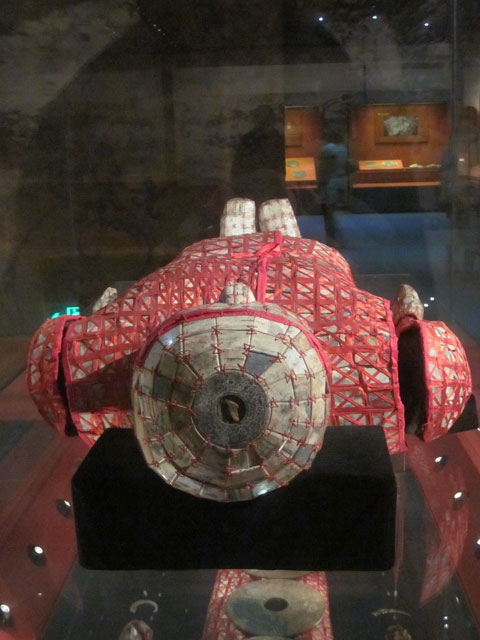In a pretty quiet part of Guangzhou city, there is an impressive museum housing an impressive display. The outside of the museum looks like an Indiana Jones ride at Disney or something, tall, windowless red rock walls etched with carvings of dragons and suns. And while the first building is not that impressive (it basically just holds some pottery and tools of daily life in the emperor’s court and smells like an old lady’s house) just keep heading out the stairs and out the top.
The museum is built on a side of a hill. That’s because in 1983, as workers were excavating the hill to make a new shopping mall, they stumbled upon a tomb: the tomb of the Nanyue king. Whose that, I hear you ask? Well, not such a famous emperor, truth be told. But like King Tut, his death is much more interesting that his life. The kings name was Zhao Mo, and he lived over 2 thousand years ago. He was a pretty weak king (lost control of some land in Vietnam his grandfather conquered) but a king is a king, and he was buried with all the trappings and riches he was accustomed to in life.
You can actually enter the excavated sight, which is cool because you can see the big stone doors that closed the tomb, the rooms which riches (and concubines bodies) were buried. But it’s basically just small rock walled rooms: not that interesting. What’s really impressive is located in a second museum building, at the very top of the hill. That’s where the silk/jade body suit is reconstructed.
It is made up of 2,291 pieces of jade woven together with silk and surrounded the kings entire body. It is the only such example of a silk and jade jacket in the entire history of China, and reflects a more modern/advanced culture that historians believed existed at the time. (Interesting side note: a student just told me that modern silk is heavier and thicker than ancient silk because of the changing diet of the silkworms. As people relied on silkworms, and began farming them like pigs and cows, they changed the worms diet to be more nutritious and efficient. Over time this had led to thicker silk. They even experimented with some silkworms to see if a return to their original, natural diet would bring back the finer silk, but it turned out to be not the case. They have evolved to produce thick silk, which makes silk garments heavier than their ancient counterparts.)
Jade was a precious stone back in the day, and often used by emperors and powerful people. The suit of jade was thought to help the soul of the emperor get to heaven easily. In addition to the 2,291 pieces his body was covered in large circular jade discs with holes in the middle. There was 47 jade discs laid on top of, and under, his body. And just for good measure, they threw a big bag of pearls into his mouth, laid his head on a pearl embroidered pillow and put a pearl jacket over his chest.

And what emperors tomb would be complete without some human sacrifices. There were 15 bodies found in the tomb, several of which were concubines, the others servants. In addition to the bodies they found bronze bells, bronze mirrors, gold inlay statues, gold seals, many different statues and carvings as well as chairs, tools and other household items. (All decked out in bronze and gold ‘natch.) The tomb also included China’s oldest and longest folding screen.

The tomb of the Nanyue King is a totally unique look into the burial customs of a culture not well known. When you think of a Chinese emperor, you think of the Forbidden City, giant palaces and Beijing. But before the country was unified (and even after it was) the dynasties and emperors were constantly changing, combining different cultures and lands together. So a look at the Nanyue kings tomb is a look into an lesser known period of Chinese history. if you ever find yourself in Guangzhou, I highly recommend it.




Thanks, I went there 2 years ago. Those pots and bronze are also good.